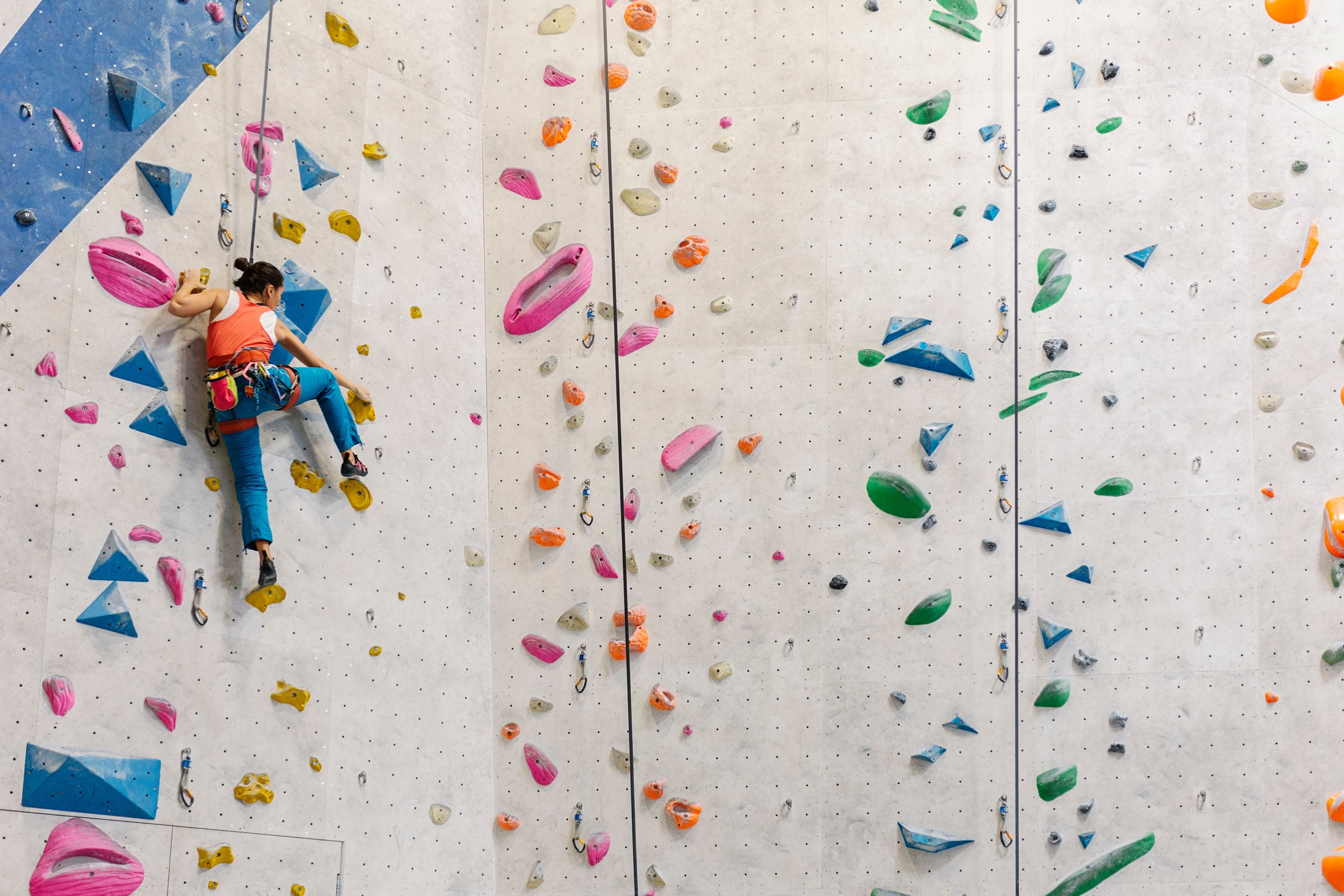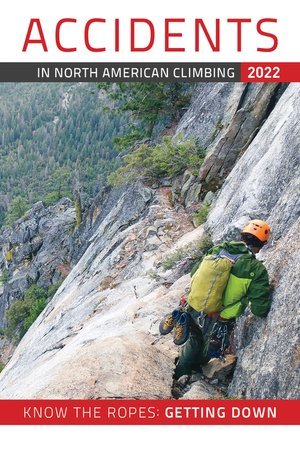The following report will appear in the 2023 edition of Accidents in North American Climbing. You can purchase the 2022 book and many previous editions through the AAC Store.
*A previous version of this Prescription used a photo from the Spot Gyms, however, the accident DID NOT occur at any of the Spot gyms, it occurred in a gym in NC. There has never been an accident of this kind at the Spot gyms.*
Failure To Clip Into Auto Belay
Asheville, North Carolina
This month we have an indoor gym accident of a type that sadly occurs with some frequency. This accident has a happy ending and a powerful lesson.
On December 14, 2022, Adam Herzog (43) miraculously survived a fall in which he suffered severe injuries after failing to clip into an auto belay in a climbing gym. Upon finishing the climb, he simply let go, and fell 45 feet to the ground. “I feel very lucky to be alive and not paralyzed,” said Herzog.
In Herzog’s own words:
“The fall resulted in a skull fracture, bilateral pulmonary contusions, three spinal fractures, right proximal radius fracture, left distal radius fracture, right pilon fracture (ankle shattered), left fibula fracture and a severe concussion.” His recovery is ongoing, “I was in the ICU on a ventilator for two days, and in the hospital for 15 days. I am expected to make a pretty full recovery. The pilon fracture may have some long-term effects and I lost some extension in the right arm.”
His post-accident recollections:
“I awoke in a fog of drugs. A tube was jammed down my throat. A ventilator forced air into my chest unnaturally with positive pressure. The next day I woke up extubated. My wife was there as always, helping me through another crash. But this one felt bigger than the others.
Adam rappelling before his accident. PC: Zach Frayser
“The next fifteen days I lay on the slick mattress of a hospital bed, intermittently conscious, asleep, exhausted, confused, and occasionally keenly aware that I had a long recovery ahead. I spent the next several weeks mulling over the events of December 14th. ‘How could I be so stupid?’ I wondered again and again. I beat myself up, apologized to my friends, family, and the staff at the climbing gym. I could not believe I would climb to the top of a route without clipping in. It seemed impossible.
“My friends reassured me. ‘It was an accident, man. It happens.’ A surprising number of people had similar stories of friends who took big falls on auto belays. I googled it and found a number of gym related accident reports.”
Analysis
Herzog writes, “I’ve been a paramedic for 22 years and a nurse for 14. In the medical field we refer to the ‘Swiss Cheese Model’ of medical errors. All the holes line up and boom, somebody dies. My accident was a perfect storm of mistakes that coincided with catastrophic results. They are listed here in the interest of preventing other climbers from falling into the same trap:
1. Hubris: I am not an expert climber. But I am an elite whitewater kayaker. I have been padding for over thirty years. The morning of my fall I paddled the Green River at high water. Once off the Green, I thought my risk exposure was over for the day. I didn’t treat the gym with the same respect I brought to the river. I should have.
2. Heuristics: Heuristics are mental shortcuts. They help us navigate our daily lives and can be useful or harmful. In my mind, “outside = dangerous, inside = safe.” When I climbed outdoors, I neurotically practiced setting up belays, cleaning routes, and rappelling before heading out. But I saw the gym as contrived, manufactured, and fake. A fifty-foot wall is a fifty-foot wall. It doesn’t matter if there are four walls and a ceiling around it.
3. Inattention: I don’t bring my phone to the climbing wall so that I am not distracted. But the day I fell, I was preparing for a paramedic recertification exam. I studied a book between routes. I wonder if that distraction contributed to my fall.
4. Deviation: I have a system I usually stick to religiously. I climb a route, unclip, walk away, and take 5-10 minutes to rest before I approach the wall again. Before I fell, I climbed halfway up a route and dropped back down to the ground. I unclipped but instead of walking away, I immediately got back on the wall. The small deviation from my normal routine removed the visual cues that usually lead to me clipping into my harness. I am 6’4” so when standing right next to the wall, my line of sight is well above the gate.
5. Redundancy: I was climbing alone so there was no one to double check my system. In top rope and lead belay we constantly check each other’s knots. But on the auto belay it’s up to the climber to double check his or her system. In my haste I neglected to check anything.
6. Focus: The route I was on was a white (marked) 5.10. That grade is the upper limit of what I climb. Because I was at the edge of my ability, I was ultra-focused on the route and holds. That is why I didn’t notice the rope was not retracting as I climbed. Had I been on an easier route I suspect I would have been more attentive.
Let’s wish Adam Herzog a swift recovery. PC: John Parmenter
“These six factors led to my fall. I sit in a wheelchair typing this up, grateful I will only have to live in it for a couple of months. I hope that by writing this, I may prevent future incidents.
“Auto belay devices almost never fail. But people do. As long as humans are involved, mistakes happen. Are there steps gyms could take to prevent other terrible falls? Maybe, but ultimately it is the climber’s responsibility to climb safely. The gym can provide measures to mitigate risk, but we must engage those measures, and know that if we work around them, there is nothing between us and the gym floor.”
Join the Club—United We Climb.
Get Accidents Sent to You Annually
Partner-level members receive the Accidents in North American Climbing book every year. Detailing the most noteworthy climbing and skiing accidents each year. Climbers, rangers, rescue professionals, and editors analyze what went wrong, so you can learn from others’ mistakes.
Rescue & Medical Expense Coverage
Climbing can be a risky pursuit, but one worth the price of admission. Partner-level members receive $7,500 in rescue services and $5,000 in emergency medical expense and coverage. Looking for deeper coverage? Sign up for Leader-level and receive $300k in rescue services.
From The Editor
Happy New Year! I’m still in Spain, clipping bolts and enjoying the good things that this country has to offer. Chulilla attracts climbers of all levels to its world-class limestone walls and is especially busy during the Christmas and New Year holiday season.
This crag dates back to the 1990s, and as such, should be reasonably clear of loose rock. However, a few days ago, a climber dislodged a baseball-sized stone while we were at the crag. It landed amid a cluster of belayers and onlookers. No one was struck, but the next day, one of my partners took the warning to heart and showed up wearing a helmet for belaying. Last night, a different partner was stuck by a small rock, apparently dislodged by a flock of birds perched on a ledge. An informal count at the crag revealed that about fifty percent of climbers were wearing a helmet.
To wear a helmet is a personal choice. When I started climbing, virtually no one owned, much less wore, a climbing helmet. Helmet wearing was considered by many as unnecessary. These days, I wear helmets while adventure climbing and now bring them to the sport crag. It’s a hard-earned lesson, as over the decades, I’ve had several head-related climbing accidents—one in which I was struck on my helmet-less head by falling ice, two in which I fell and my helmet probably saved my life, and one in which I was struck by falling rock that narrowly missed my head. These accidents took place on ice, alpine, or big wall climbs. — Pete Takeda
For an in-depth and humorous take on helmet technology from our friends @HardIsEasy, see below.
Accidents in North American Climbing to be Translated to Chinese
The cover 2022 Accidents in North American Climbing.
Several leading Chinese climbers from Beijing Xiangpan Outdoor Sports, are planning to translate the 2022 Accidents in North American Climbing. According to Chinese climber Zhou Peng, “All our work is done out of passion and voluntariness, without remuneration, and free of charge for climbers.”
About ANAC
This educational book has been published annually by the American Alpine Club for 75 years. The mission has always been the same: publish stories and analysis of climbing accidents so that other climbers can learn about the causes of accidents and avoid similar problems in the future. All of the stories and photos in the publication are donated by climbers, rescuers, and park rangers who share the same goals.
This publication documents accidents in the United States, Canada, and Mexico, and some of the problems described here are unique to those locations. However, in the large majority of cases, these lessons will be useful to rock climbers and mountaineers in China or anywhere else in the world. With this in mind, we are very happy to see this translation of the 2022 edition of the Accidents in North American Climbing book, and we hope that Chinese students and climbers will learn a lot from these stories.
— Dougald MacDonald, Executive Editor, American Alpine Club















